Program Information
The Physics of High Power Radiofrequency Isolation in a Novel Compact Linear Accelerator Based MRI Guided Radiation Therapy System
J Lamb1*, D Low1 , S Mutic2 , S Shvartsman3 , T Chmielewski3 , G Fought3 , A Sharma3 , J Dempsey3 , (1) University of California, Los Angeles, Los Angeles, CA,(2) Washington University School of Medicine, Saint Louis, MO, (3) ViewRay, Inc., Oakwood Village, OH
Presentations
TU-H-BRA-1 (Tuesday, August 2, 2016) 4:30 PM - 6:00 PM Room: Ballroom A
Purpose: To develop a method for isolating the radiofrequency waves emanating from linear accelerator components from the magnetic resonance imaging (MRI) system of an integrated MRI-linac.
Methods: An MRI-guided radiation therapy system has been designed that integrates a linear accelerator with simultaneous MR imaging. The radiofrequency waves created by the accelerating process would degrade MR image quality, so a method for containing the radiofrequency waves and isolating the MR imager from them was developed. The linear accelerator radiofrequency modulator was placed outside the room, so a filter was designed to eliminate the radiofrequency corresponding to the proton Larmour frequency of 14.7 MHz. Placing the radiofrequency emitting components in a typical Faraday cage would have reduced the radiofrequency emissions, but the design would be susceptible to small gaps in the shield due to the efficiency of the Faraday cage reflecting internal radiofrequency emissions. To reduce internal radiofrequency reflections, the Faraday cage was lined with carbon fiber sheets. Carbon fiber has the property of attenuating the radiofrequency energy so that the overall radiofrequency field inside the Faraday cage is reduced, decreasing any radiofrequency energy emitted from small gaps in the cage walls.
Results: Within a 1.2 MHz band centered on the Larmor frequency, the radiofrequency (RF) leakage from the Faraday cage was measured to be -90 dB with no RF on, -40 dB with the RF on and no shield, returning to -90 dB with the RF on and shields in place. The radiofrequency filter attenuated the linear accelerator modulator emissions in the 14.7 MHz band by 70 dB.
Conclusions: One of the major challenges in designing a compact linear accelerator based MRI-guided radiation therapy system, that of isolating the high power RF system from the MRI, has been solved. The measured radiofrequency emissions are sufficiently small to enable system integration.
Funding Support, Disclosures, and Conflict of Interest: This research was funded by ViewRay, Inc., Oakwood, OH
Contact Email:

